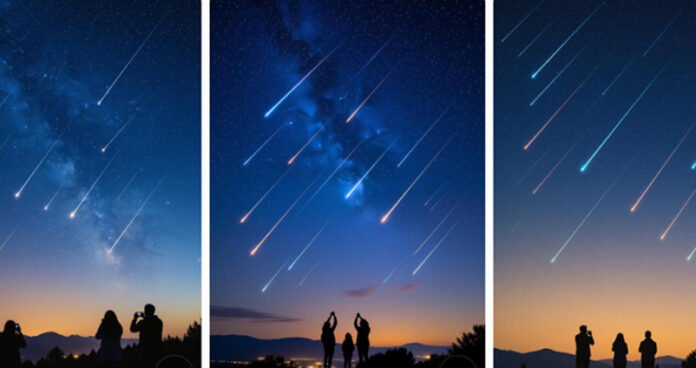Global — October 14, 2025
Astronomy enthusiasts around the world are gearing up for one of the rarest and most spectacular meteor displays of 2025: the Draconid meteor shower, which is expected to peak this October, offering a stunning celestial spectacle visible primarily across the Northern Hemisphere.
The Draconids, associated with Comet 21P/Giacobini-Zinner, are known for their unpredictable outbursts, sometimes producing thousands of meteors per hour in what is called a “meteor storm.” According to astronomers, this year’s event may see up to 10,000 meteors per hour at peak intensity — a once-in-a-decade phenomenon that could mesmerize skywatchers from Europe to North America and parts of Asia. (arxiv.org)
“Draconids are unique because they can produce sudden, intense bursts of meteors,” said Dr. Caroline Kessler, astrophysicist at the European Space Observatory. “This unpredictability makes them a thrill for both professional astronomers and casual stargazers alike.”
When and Where to Watch
The Draconid meteor shower is expected to peak on the night of October 8–9, 2025, with optimal viewing conditions just after dusk in locations with clear skies and minimal light pollution. The meteors appear to radiate from the constellation Draco, near the Dragon’s head, hence the name “Draconids.”
Key viewing tips include:
Find a dark location: Away from city lights to improve visibility.
Dress warmly: Northern Hemisphere nights are cool in October.
Use reclining chairs or blankets: To comfortably watch the sky for extended periods.
Be patient: Meteor rates vary, and the most spectacular displays often last only minutes.
Unlike other meteor showers, the Draconids are best viewed in the early evening, rather than after midnight, making it ideal for families and casual skywatchers.
Scientific Significance
The Draconid meteor shower offers more than just a visual spectacle — it provides astronomers with important scientific insights into the solar system. Researchers use radar and optical observations to:
Track the composition and speed of meteoroids entering Earth’s atmosphere.
Study comet debris trails, which can reveal the history and orbit of Comet 21P/Giacobini-Zinner.
Monitor atmospheric interactions, helping to improve models of how meteors burn up and produce visible streaks.
“Every meteor that burns up in our atmosphere tells a story about the solar system’s past,” said Dr. Kessler. “The Draconids are like cosmic time capsules.”
Why 2025 is Special
The Draconids are particularly notable this year because Earth’s orbit will intersect dense dust trails left by Comet 21P. Meteorologists predict potential “meteor storms” during the peak, creating the possibility of seeing hundreds to thousands of meteors per hour, far exceeding normal Draconid activity.
Additionally, the moon phase in October 2025 is nearly new, providing dark skies that enhance visibility. This rare combination of factors makes this Draconid shower one of the most anticipated astronomical events of the decade.
Global Enthusiasm
Astronomers and amateur stargazers alike are preparing telescopes, cameras, and even meteor counting apps to document the phenomenon. Science museums, observatories, and astronomy clubs across Europe, North America, and Asia are hosting special Draconid viewing events, some with live online streams for those who cannot travel.
“The Draconids remind us of the beauty and unpredictability of the universe,” said Dr. Kessler. “It’s a chance for everyone to look up and experience something truly extraordinary.”
Conclusion
The 2025 Draconid meteor shower promises to be a rare, breathtaking event, uniting science enthusiasts, photographers, and casual observers under the night sky. Whether you are in Europe, North America, or Asia, mark your calendars for October 8–9 — this is an astronomical show you won’t want to miss.
With its stunning visuals, scientific value, and once-in-a-decade potential intensity, the Draconid meteor shower is both a spectacle and a reminder of humanity’s connection to the cosmos.
















